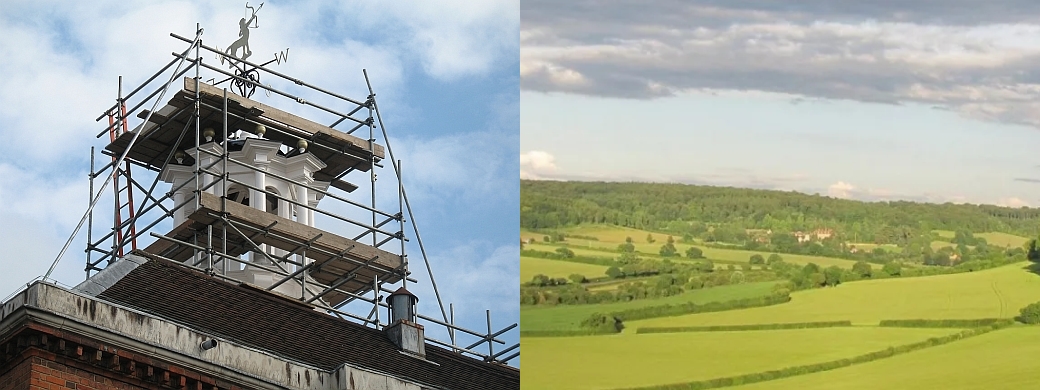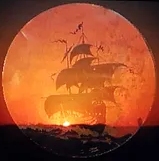There was a programme about Wayfaring on the radio, based on a book called The Gentle Art of Tramping, written in 1927. In those days “gentlemen of the road”, often old soldiers, would be seen on foot across Britain, communing with Nature, find rough shelter each night, doing a little casual labour here and there. The practice is not dead it seems, for they interviewed a few modern exponents of this way of life.
My own wayfaring seldom extends beyond fifteen miles at a time. Typically I get out for a couple of hours to explore the endless network of footpaths which traverses the gentle Chiltern Hills and slices through towns too, away from the busy roads. Britain is fortunate in the way these footpaths are maintained by county councils and protected by law.
 My house is not far from the traffic light at the bottom of the hill.
My house is not far from the traffic light at the bottom of the hill.
The close-packed houses and flats on the other side of the hill were built in the 1990s. Mine was built in 1901, to the same design as those on the left of the photo above.
A couple of minutes later, looking over the rooftops in another direction, I see the beckoning countryside.
I walked in that direction, along Toweridge Lane, and was barked at by a Great Dane named Farley. I was glad there was a five-barred gate separating us. His owner came over and said hello.
Farley is affectionate as you see, but weighs thirteen stone and has alarming claws. I asked his owner what it’s like to have such a big pet. He said he doesn’t think of him as big, because he owns horses too.
That was a few days ago. Today I went walking round Chalfont St Giles, the little town where Milton finished Paradise Lost, and Chalfont St Peter.
In a field stood a lady with straw-coloured hair. I asked her if she owned the horses. No, but she loves them, and comes often.
One of them is particularly affectionate. She allows it to munch her hair. I allowed it to munch my fingers. It was very gentle, happy to spend all day with us, nuzzling and being caressed. We (the lady and I) spoke of the love of animals. I mentioned various books, including Michelangelo’s Finger by Raymond Tallis, all about the human index finger, and pointing, and the inability of animals to point, even the pedigree dog known as a Pointer; because pointing is a complex thing, and a prerequisite to the development of language as we know it. Which led to the fact, which Tallis points out, that autistic people do not point, except when instructed to do so. Which led to my mention of Dr Temple Grandin, an autistic woman who empathizes with cattle, and uses this faculty to design slaughterhouses. As I rambled on, the lady continued her love affair with the horse before my eyes; except when the horse offered me his love too, with nuzzling and kissing and finger-munching. I thought he was seeking out the apples I had in my knapsack, but he wasn’t interested, until I offered one to him in my hand. We discussed love and whether it could be disinterested: at least, the love between humans and other species.
We said goodbye and I walked on, not really knowing where I was going, but I’d set up a GPS device to tell me where I’d left the car. The footpath went right through the National Epilepsy Society’s Respite Centre, a spacious set of buildings laid out like a village: very peaceful. Somewhere on the other side, after several loops and crossings of the same path, I passed a farm.
Here it is, Tipping’s Farm.
But as usual, I had my head in the clouds, and turned to look at another part of the sky.
It was a long way back to where I’d parked the car, near Milton’s Cottage, but there were plenty of late blackberries for nourishment along the path.










Wow, what a wonderful little journey you had Vincent.
That's interesting that autistic people don't point. I wonder if it's because they're more locked inside themselves.
LikeLike
“Gentleman of the road” sounds like a very genteel euphemism for a homeless person.
LikeLike
“… the lady continued her love affair with the horse before my eyes.”
That sounded a lot dirtier to me that it probably should have.
LikeLike
Yes, Rubye, that’s pretty much the reason why autistic people don’t point. To put it in more detail, pointing requires that you can imagine another person being able to look along the same line that you are indicating, to see what you can already see; whilst being able to understand that until you point the thing out, they are unable to locate it in the visual field.
Apparently, an autistic person is unable to make this kind of imaginative leap into someone else’s viewpoint, and cannot even think about his or her own future. Which puts a context on the ability which Temple Grandin discovered in herself, to make the imaginative leap into the perceptual world of the cow, who (presumably) has similar limitations to the autist.
LikeLike
Vincent, you are stopping to smell the roses and you are offering us the opportunity to share it a little, too.
I liked the Great Dane, I'm sure if you return to talk to him again, you'll find him less daunting.
A munching affectionate horse is an interesting find, especially, as it is not munching grass or carrots, but 'her' and you; that is, till you offered horsey an apple.
Nice one, and good pictures too!
LikeLike
Very nice. Gave me a little vacation away from my own world. Some days I spend so much time locked up inside my own head it's difficult to find my way out. Then there you were with the door open saying “Over here.” That was refreshing. Thank you.
LikeLike
Lovely post Vincent with beautiful pictures. Your home is located in a great country for walks. I feel the practice of taking off on a long walk across the country sounds absolutely delightful.
LikeLike
What a wonderful wandering day you had, Vincent. Lovely how you’ve expressed it with photos to match. I’ve seen a couple of great Danes over the past weeks. I can’t help but stare with my mouth agape at their huge size.
I started reading Temple Grandin’s book, Thinking in Pictures, a couple weeks back. So far, I’m finding it to be very interesting, informative, and uplifting.
The close up of the beautiful horse and the woman is my favorite. It captures such a dear moment of mutual affection.
LikeLike